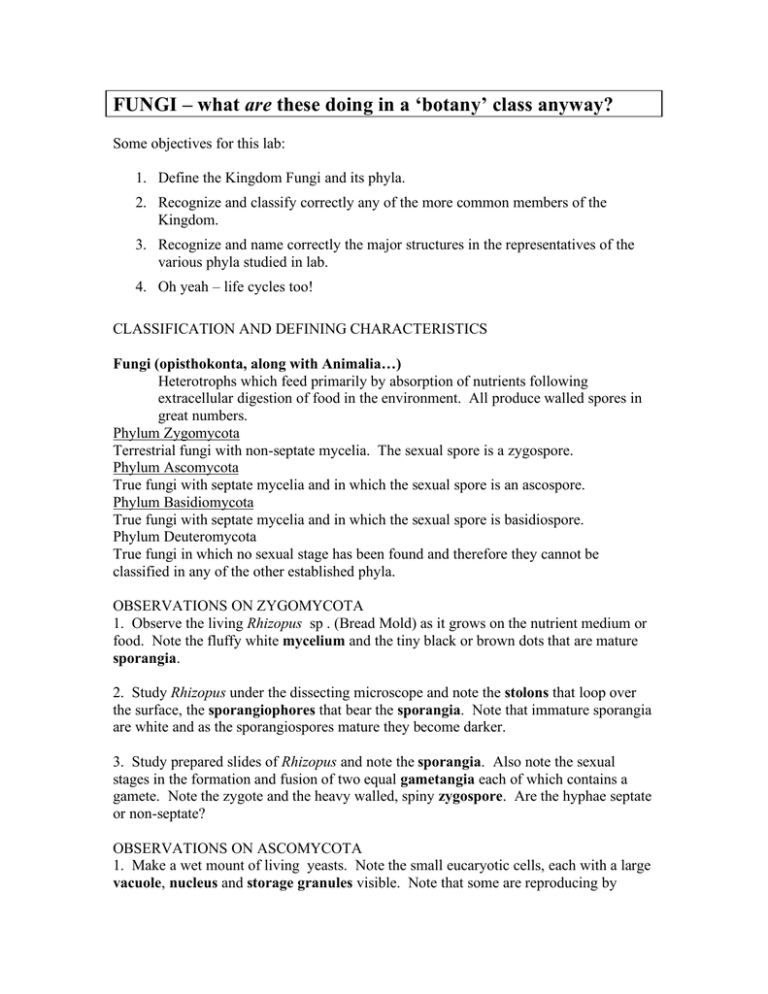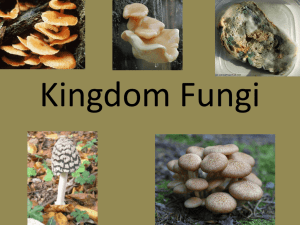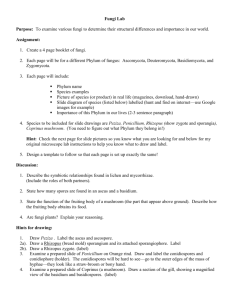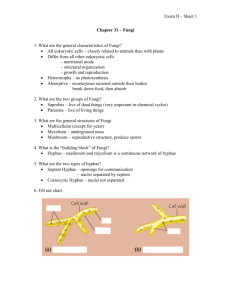are
advertisement

FUNGI – what are these doing in a ‘botany’ class anyway? Some objectives for this lab: 1. Define the Kingdom Fungi and its phyla. 2. Recognize and classify correctly any of the more common members of the Kingdom. 3. Recognize and name correctly the major structures in the representatives of the various phyla studied in lab. 4. Oh yeah – life cycles too! CLASSIFICATION AND DEFINING CHARACTERISTICS Fungi (opisthokonta, along with Animalia…) Heterotrophs which feed primarily by absorption of nutrients following extracellular digestion of food in the environment. All produce walled spores in great numbers. Phylum Zygomycota Terrestrial fungi with non-septate mycelia. The sexual spore is a zygospore. Phylum Ascomycota True fungi with septate mycelia and in which the sexual spore is an ascospore. Phylum Basidiomycota True fungi with septate mycelia and in which the sexual spore is basidiospore. Phylum Deuteromycota True fungi in which no sexual stage has been found and therefore they cannot be classified in any of the other established phyla. OBSERVATIONS ON ZYGOMYCOTA 1. Observe the living Rhizopus sp . (Bread Mold) as it grows on the nutrient medium or food. Note the fluffy white mycelium and the tiny black or brown dots that are mature sporangia. 2. Study Rhizopus under the dissecting microscope and note the stolons that loop over the surface, the sporangiophores that bear the sporangia. Note that immature sporangia are white and as the sporangiospores mature they become darker. 3. Study prepared slides of Rhizopus and note the sporangia. Also note the sexual stages in the formation and fusion of two equal gametangia each of which contains a gamete. Note the zygote and the heavy walled, spiny zygospore. Are the hyphae septate or non-septate? OBSERVATIONS ON ASCOMYCOTA 1. Make a wet mount of living yeasts. Note the small eucaryotic cells, each with a large vacuole, nucleus and storage granules visible. Note that some are reproducing by budding (can you see it?). 2. Observe living Penicillium or Aspergillus growing on the agar in a petri plate. Note that each colony has a fluffy white mycelium which is covered in the central part by greygreen dust of conidia (conidium) or conidiospores. You may want to look at this under the dissecting microscope. 3. Study prepared slides of Penicillium showing conidia formation. 4. Study a prepared slide of a cross section of Peziza showing asci and ascospores. OBSERVATIONS ON BASIDIOMYCOTA 1. Select a mushroom which is a fruiting structure produced by a large underground mycelium and note the stipe or stalk, the pileus or cap, the gills in the pileus and the annulus which is a ring of tissue on the stipe. 2. Study a prepared slide of a section through the cap of Coprinus. Note the gills made up of hyphae which have been cut through. Note the surface of each gill is covered with small cells arranged like pile on a carpet. Each of these is a basidium. Each basidium produces four basidiospores which are large, somewhat spiny, dark structures falling from the surface of the gills. OBSERVATIONS ON LICHENS 1. Lichens are combinations of algae and fungi. Observe the lichens and note color and shape differences. 2. Observe slides showing this symbiotic relationship. Note the hyphae, ascocarp with asci and the one celled algae.





